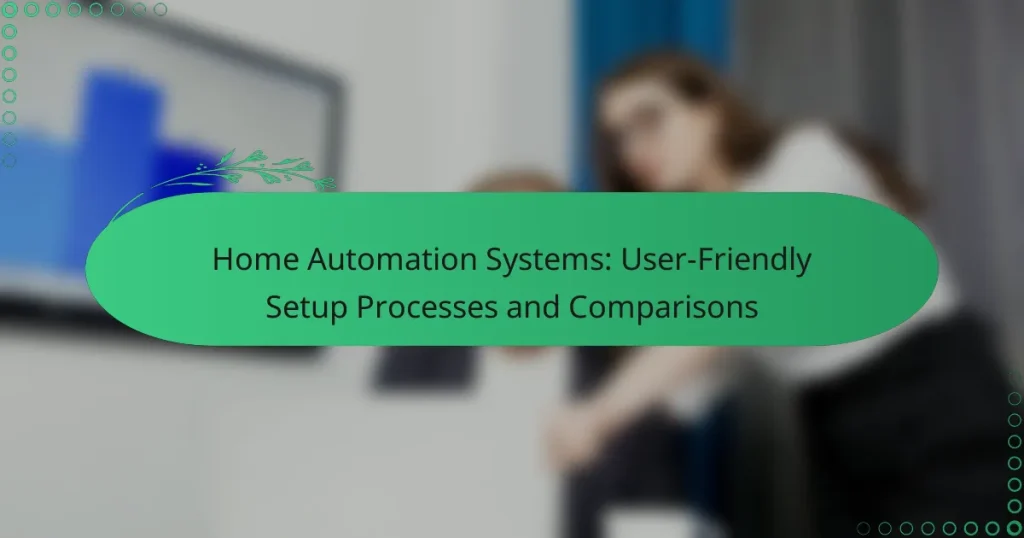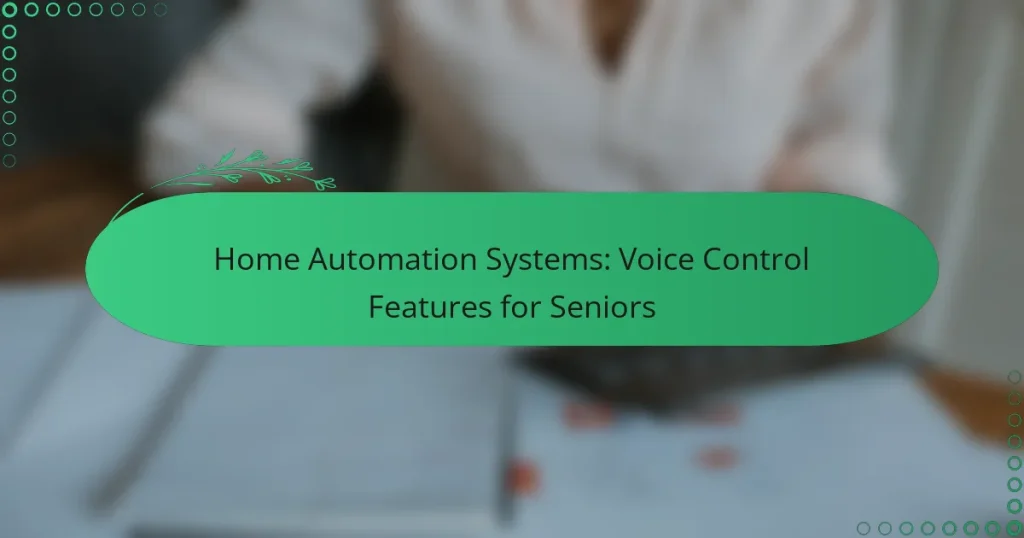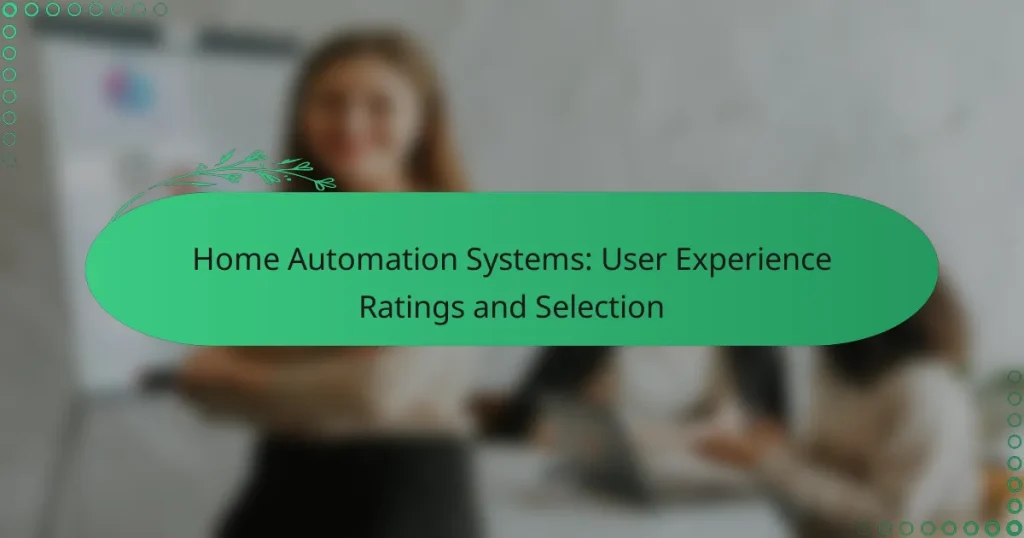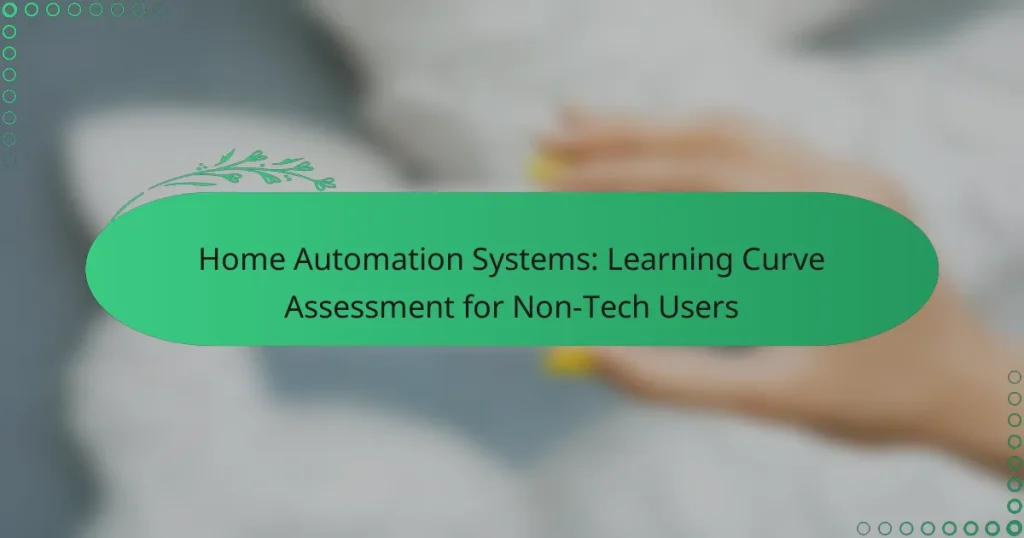Home automation systems significantly enhance daily living by integrating technology to simplify tasks and improve convenience. Designed with user-friendliness in mind, these systems allow effortless control over various home functions, making them ideal for beginners. When selecting a system, it’s essential to consider compatibility with existing devices, installation ease, and future scalability.
Home Automation Systems: Voice Control Features for Seniors
Home Automation Systems: User Experience Ratings and Selection
Home Automation Systems: Learning Curve Assessment for Non-Tech Users
How can home automation systems improve ease of use?
Home automation systems enhance ease of use by simplifying daily tasks through technology integration. They allow users to control various home functions effortlessly, making life more convenient and efficient.
Voice control integration
Voice control integration allows users to manage their home automation systems using simple voice commands. Devices like Amazon Alexa or Google Assistant can be linked to smart home products, enabling hands-free operation for tasks such as adjusting lighting or controlling the thermostat.
This technology is particularly beneficial for individuals with mobility challenges, as it eliminates the need for physical interaction with devices. To maximize effectiveness, ensure that your voice assistant is compatible with your home automation system.
Mobile app accessibility
Mobile app accessibility provides users with the ability to control their home automation systems from anywhere using a smartphone or tablet. Most systems offer dedicated apps that allow for remote management of devices, monitoring energy usage, and receiving alerts.
When selecting a home automation system, consider apps that are intuitive and user-friendly. Look for features such as customizable notifications and easy device pairing to enhance your experience.
Automated routines
Automated routines enable users to schedule and automate tasks, creating a seamless living environment. For instance, you can set your lights to turn on at sunset or program your coffee maker to start brewing in the morning.
To create effective routines, identify daily habits and consider using triggers such as time, location, or device status. This can significantly reduce the time spent on repetitive tasks and enhance overall comfort.
User-friendly interfaces
User-friendly interfaces are crucial for ensuring that home automation systems are accessible to everyone, regardless of technical skill. A well-designed interface should be intuitive, allowing users to navigate easily and manage their devices without confusion.
When evaluating systems, look for those that offer clear visuals, straightforward menus, and helpful tutorials. This will help you and your family quickly adapt to the technology and make the most of its features.
Remote monitoring capabilities
Remote monitoring capabilities allow users to keep an eye on their home from anywhere, providing peace of mind. Many systems offer real-time alerts and video feeds, enabling you to check on security cameras or receive notifications about unusual activity.
To ensure effective remote monitoring, choose a system that provides reliable connectivity and robust security features. Regularly update your software to protect against vulnerabilities and maintain functionality.
What are the best home automation systems for beginners?
The best home automation systems for beginners are user-friendly and offer seamless integration with various smart devices. Popular options include Google Nest Hub, Amazon Echo Plus, Samsung SmartThings, and Apple HomeKit, each providing distinct features that cater to novice users.
Google Nest Hub
Google Nest Hub is an intuitive smart display that acts as a central control point for your home automation. It allows users to manage compatible devices through voice commands or a touch interface, making it accessible for those new to smart home technology.
With Google Assistant built-in, you can easily control lights, thermostats, and more. The Nest Hub also features a visual interface that displays information like weather updates and calendar events, enhancing usability for beginners.
Amazon Echo Plus
The Amazon Echo Plus is a versatile smart speaker that integrates with a wide range of smart home devices. It includes a built-in Zigbee hub, which simplifies the connection process for compatible devices, making it ideal for beginners.
Using Alexa, users can issue voice commands to control lights, locks, and other smart devices. The Echo Plus also supports routines, allowing you to automate multiple actions with a single command, such as turning off all lights at bedtime.
Samsung SmartThings
Samsung SmartThings is a comprehensive home automation platform that supports a variety of devices from different manufacturers. It offers a user-friendly app that allows beginners to set up and manage their smart home easily.
SmartThings provides automation features that let users create custom routines based on time, location, or device status. This flexibility enables beginners to tailor their home automation experience to their specific needs without overwhelming complexity.
Apple HomeKit
Apple HomeKit is designed for users within the Apple ecosystem, providing a secure and straightforward way to control smart home devices. Beginners can easily set up HomeKit through the Home app on their iPhone or iPad, allowing for seamless integration with other Apple products.
With Siri voice commands, users can control their devices hands-free. HomeKit also emphasizes privacy and security, making it a reliable choice for those concerned about data protection while automating their homes.
How do I choose a home automation system?
Choosing a home automation system involves assessing compatibility with your existing devices, ease of installation, cost, and scalability. Prioritize systems that integrate seamlessly with your current technology and fit your budget while allowing for future expansion.
Compatibility with existing devices
Check if the home automation system supports the devices you already own, such as smart lights, thermostats, or security cameras. Many systems work with popular brands like Philips Hue or Nest, but some may have limitations. Ensure the system can connect via common protocols like Wi-Fi, Zigbee, or Z-Wave.
Consider using a compatibility checker tool provided by manufacturers or third-party websites to verify device integration. This can save you time and money by preventing the purchase of incompatible devices.
Ease of installation
Installation can vary significantly between systems. Some require professional installation, while others are designed for DIY setups with straightforward instructions. Look for systems that offer plug-and-play features to simplify the process.
Before purchasing, read user reviews to gauge the installation experience. Systems with mobile apps that guide you through setup can be particularly helpful for those less tech-savvy.
Cost considerations
Home automation systems can range from a few hundred to several thousand dollars, depending on features and capabilities. Factor in not just the initial purchase price but also ongoing costs like subscriptions for cloud services or additional devices.
Set a budget that includes potential upgrades or expansions. Many users find that starting with a basic system and gradually adding components is a cost-effective approach.
Scalability options
Choose a home automation system that allows for easy expansion as your needs grow. Look for platforms that support a wide range of devices and features, enabling you to add new functionalities over time.
Consider systems that offer modular components or subscription services that can enhance your setup without requiring a complete overhaul. This flexibility can be crucial as technology evolves and your preferences change.
What features enhance user experience in home automation?
Key features that enhance user experience in home automation include customizable settings, integration with smart appliances, and robust security features. These elements work together to create a seamless and intuitive environment for users, allowing for greater control and convenience in managing their homes.
Customizable settings
Customizable settings allow users to tailor their home automation systems to fit their specific needs and preferences. This can include adjusting lighting schedules, temperature settings, and notification preferences. Users can often create profiles for different times of day or activities, enhancing comfort and efficiency.
When setting up customizable options, consider your daily routines and how automation can simplify them. For example, you might set your lights to dim in the evening or have your thermostat adjust automatically when you leave for work. This personalization can significantly improve your overall experience.
Integration with smart appliances
Integration with smart appliances is crucial for a cohesive home automation experience. This feature allows various devices, such as refrigerators, ovens, and washing machines, to communicate with the central system, enabling users to control them remotely. For instance, you can preheat your oven from your smartphone while on your way home.
To maximize integration, choose appliances that are compatible with your home automation platform. Look for devices that support common standards like Zigbee or Z-Wave, which can enhance interoperability. This ensures that all your smart devices work together smoothly, providing a more efficient home environment.
Security features
Security features in home automation systems are essential for protecting your home and ensuring peace of mind. These can include smart locks, security cameras, and motion sensors that can be monitored and controlled remotely. Users can receive alerts on their smartphones if unusual activity is detected, allowing for quick responses.
When selecting security features, consider options that offer real-time monitoring and easy integration with other smart devices. For example, a smart lock can be programmed to automatically lock when you leave home, while security cameras can provide live feeds directly to your mobile device. Prioritize features that enhance your safety without compromising convenience.
What are the common challenges in home automation?
Common challenges in home automation include connectivity issues, complex setup processes, and device compatibility problems. These obstacles can hinder the overall effectiveness and user experience of a smart home system.
Connectivity issues
Connectivity issues often arise due to unreliable Wi-Fi signals or interference from other devices. A weak connection can lead to delays in device response times or complete disconnection, making automation less effective.
To mitigate these problems, consider using a mesh Wi-Fi system to enhance coverage throughout your home. Regularly check for firmware updates on your devices to ensure optimal performance and security.
Complex setup processes
Many home automation systems require intricate setup processes that can be daunting for users. This complexity can lead to frustration and improper installation, which may result in malfunctioning devices.
To simplify setup, choose systems with user-friendly interfaces and comprehensive guides. Watching tutorial videos or seeking help from customer support can also streamline the installation process.
Device compatibility problems
Device compatibility problems occur when different brands or models do not work seamlessly together. This can limit the functionality of your home automation system and lead to a fragmented user experience.
Before purchasing devices, check for compatibility with your existing system or consider using a central hub that supports multiple brands. Researching user reviews can also provide insights into potential compatibility issues.



